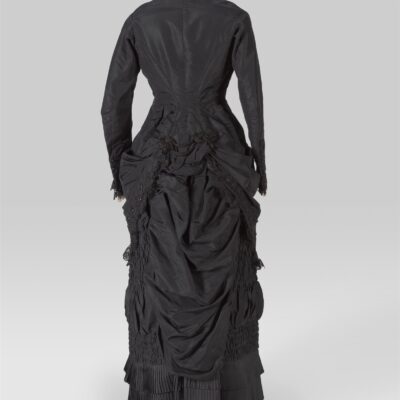
EFHA World 08.09.2023
28.10.2018
1800s1900scoutureFrench fashion
One of the most renowned French corset-makers – who combined style and medicine to create the ‘corsets of dreams.’
The image shows an advertisement for the corsets of Auguste Claverie, appeared on the French magazine Femina in 1905.
The history of the corset is quite long: it is recorded that corsets were first used in Crete in Greece, by both men and women. There, the Minoan people had a very precise idea of the ‘perfect body shape’ that could be obtained with the help of form-fitting belts and vests with leather rings constricting the waist.
This ‘vest’ evolved during the centuries, and each period has its own ‘shape’ of corset, designed according to the use and the silhouette popular at the time. During the fifteenth century, for example, the ‘cotte’, a tight fitting garment whose name meant ‘on the rib’, was first worn in France. Famously, Caterina de Medici – a very influential figure for European fashion during the sixteenth century – banned ‘thick waists’ at the French court.
The style of corsets marked also differences in ‘regional’ fashions within Europe: in England, the ‘Tudor Corset’ was reinforced with iron sticks, and was then substituted by the ‘Elizabethan Corset’, which was less rigid and made with different materials; France, Germany and Italy preferred a less stiff style to eventuate a wider hip. The 1700’s the design changed: corsets became were long-waisted, with a narrow back and a wide front. The shape of the corset influenced the posture of the wearer, constricting to pull back the shoulders and thus creating the typical shape of the time.
Although dress reformists of the late 1800s considered corsets dangerous both ethically and for the health, they kept being used, and their production marked the success of some traders, who believed corsets could change, but never go completely out of style.
In fact, in 1891, Auguste Claverie, together with Georges Bos, opened his shop in rue du Faubourg-Saint-Martin, in Paris. Claverie was an orthopedist specialised in hernia bandages, elastic belts, hygienic corsets, low varicose veins, prostheses, thus acquires a tremendous reputation. He became one of the most prominent traders in the capital. Claverie is remembered to be the inventor of ‘le Rêve’, a corset built in an elastic fabric that made it very solid and also very flexible. This is what an advertisement published in the Frenh magazine L’Illustration at the beginning of the 20th century reported:
“The corset Claverie finally realizes the ideal of the corset. What was said against the Corset? Today, he triumphs over old ostracism, thanks to the creations of Mr. A. Claverie, the great specialist in female anatomy. In the opinion of the entire medical profession, he is the first and only one to have constituted a true science of the ‘under’. The secret of its precise and methodical perfection lies entirely in its rigorously anatomical cut, and in the art with which it is adapted exactly to the particular requirements. The Corset Claverie, always made to measure, is a discreet support that softens the forms, leaves the organs all the freedom they claim by gracefully lending itself to all the movements of the body. It is an exquisite seed of sweetness and grace. It highlights the natural advantages of the woman, while giving her bust this correction of lines, a balance allowing beauty to flourish freely in the fullness of its charms. On this perfect fit, on this miracle of aesthetics, designers can throw all the dresses they like, they will unfold with even more grace that no wrinkling underneath will hinder the fall harmonious. And, what completes to characterize and place above all the others ‘Corset Claverie’ is the refined taste with which trimmings and ornaments are matched: every detail is a flowery of elegance.”
Claverie became also controversially famous because he as produced ‘Le Parisien’, a ‘dilated rubber condom’ that would even provide a ‘greater pleasure to the woman.’ The product enraged the Government that sentenced and Auguste Claverie. However, this did not stop the memory of this innovator to arrive to our times – this, mostly thanks to the material in the archives.